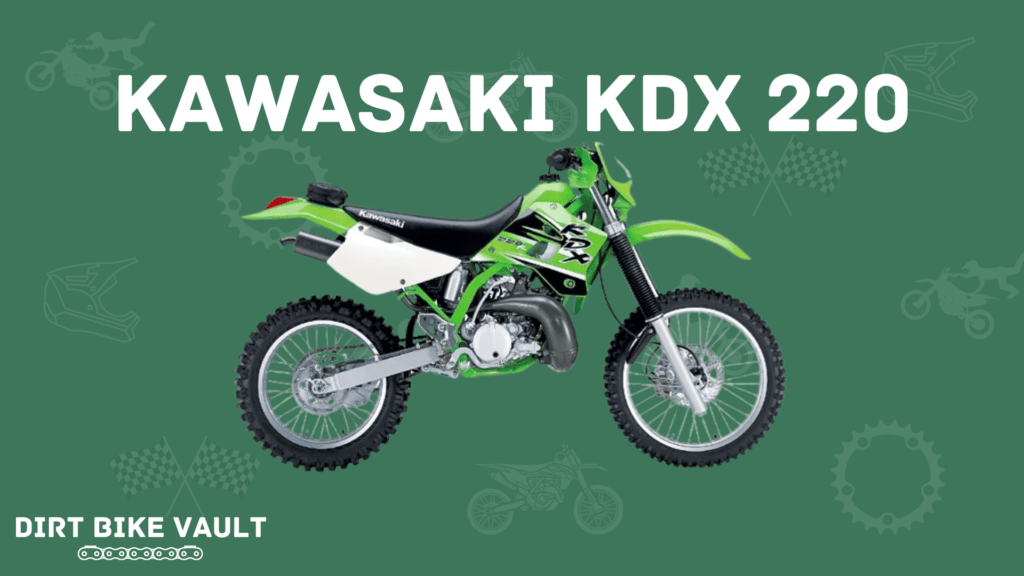If you were riding dirt bikes in the late 90’s to early 2000’s, you’re probably familiar with the popular Kawasaki KDX 220 that we’re going to cover here in this article. In fact, at one point, it was one of the most popular motorcycles ever made.
It was affordable and a ton of fun.
Let’s go back in time a bit and revisit the beloved Kawasaki KDX 220. (You might also like our overview of the KLX 650 Big Bore Kit or the Honda XR600R 1994.)
About the Kawasaki KDX 220
The Kawasaki KDX 220 is a capable and versatile off-road dirt bike. Kawasaki manufactured the KDX 220 from 1997 to 2006. With numerous improvements, the KDX 220 remains one of Kawasaki’s most popular intermediate enduro dirt bikes.
Out of the box, it didn’t quite have the power of some of the KDX 220’s competitors, but it had a ton of potential for aftermarket parts, and it was much more affordable.

KDX 220 Specs
Engine and transmission
The Kawasaki KDX 220 engine is based on the original and well-proven KDX 200 engine. It is a 2-stroke, single-cylinder machine with a displacement of 216cc, a bore of 69mm, a stroke of 58mm, and a compression ratio of 7.2:1. When compared to the KDX 200, it has an increase in the piston bore of 3mm, which increases overall horsepower and torque.
3mm may not sound like a lot, but it was quite a bit stronger than the KDX 200 in regard to power.
The Kawasaki Integrated Power Valve System (KIPS) is also present in this engine and increases the compression and sealing of the piston. It is a unique system that delivers equal power and torque during any RPM stage.
The KDX 220 engine is liquid-cooled. The system includes two radiators and a water pump with a mechanical seal type.
Kawasaki KDX 220 has a 6-gear transmission box with a cable and multi-plate clutch. It has smooth shifting through all the gears and can deliver the maximum power and torque from the engine to the rear wheel.
If you’re having any trouble with the bike running right, check out our guide on lean bog vs rich bog.
Tires and suspension
Since the KDX 220 is an enduro dirt bike, it has tires with dimensions and characteristics just for that purpose.
The bike’s front tire is 80/100-21, with 80 being the width, 100 being the tire height (measured in % from the width), and 21 being the tire’s diameter. The rear tire is thicker but smaller, measuring 100/80-18.
The front and rear wheels are equipped with hydraulic disc brakes.
As far as suspension is concerned, the bike has an aluminum front fork composed of two parts, a cast upper part and a forged lower part for increased durability.
The fork can be adjusted because it has a 20-way compression damping, allowing maximum wheel travel of 11.4 inches.
The rear suspension comprises a single mono-shock shock absorber with an 18-way rebound and 20-way compression damping. The mono-shock has an adjustable thread, allowing the spring’s preload to be modified according to the rider’s weight.
The rear wheel has a maximum travel of 11.8 inches.
Chassis, weight, and handling
The overall build quality of the KDX 220 is excellent, as it is made from a reinforced, high-tensile steel frame and has a dry weight of 223lbs (100kg).
It has an overall length of 83.5 inches (2121mm), an overall width of 35 inches (889mm), and an overall height of 48.4 inches (1230mm).
The bike has a relatively short wheelbase of 56.6 inches (1437mm).
The entire frame is box-like, resulting in a rigid bike body. The swing arm pivot is welded directly onto the bike’s frame, making the entire unit compact and strong.
The bike has a ground clearance of 13.4 inches (340mm) and a seat height of 36.2 inches (920mm).
How Does the KDX 220 Compare to KDX 200?
Both bikes have 2-stroke, liquid-cooled, single-cylinder engines. The KDX 200 can deliver around 37 horsepower at 8000 RPM and around 34.3 nm of torque at 7000 RPM. On the other hand, the KDX 220 is more powerful, delivering around 50 hp at 7500 RPM.
Both bikes have a similar top speed of around 70 mph (although one rider claims to have gotten his KDX 220 to do over 100 mph, even though the KDX 220 has a bit more horsepower. This is because the KDX220 power is seen in the lower to mid-range RPMs when the bike can deliver more torque to the rear wheel.
Both bike models have a fuel-tank capacity of 2.9 gallons (11 liters).
Frequently Asked Questions about the Kawasaki KDX 220
The KDX 220 has about 50 horsepower at 7500 rpm.
A KDX 220 weighs about 223 pounds.
A KDX 220 does about 70 mph, but one rider, according to Cycle Insider, was able to get his KDX 220 to do over 100 mph.
The last year of the KDX 220 was 2006.
Kawasaki stopped making the KDX because it was ending the production of it’s 2 stroke dirt bikes.
A KDX220 weighs about 223 pounds.
The Kawasaki KDX220 was made from 1997 to 2006.



